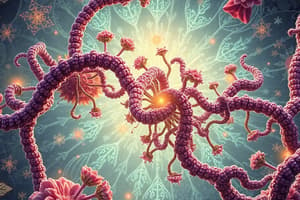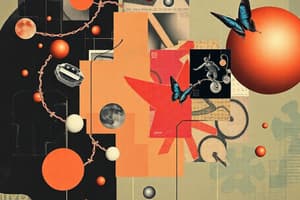Podcast
Questions and Answers
What does first pass metabolism refer to?
What does first pass metabolism refer to?
- The reabsorption of drugs after excretion into bile.
- The process of drug absorption via the bloodstream.
- The elimination of drug metabolites through urine.
- The initial breakdown of a drug in the liver before reaching systemic circulation. (correct)
Which organ is primarily responsible for the metabolism of drugs?
Which organ is primarily responsible for the metabolism of drugs?
- Liver (correct)
- Spleen
- Heart
- Kidney
What role does cytochrome P450 play in drug metabolism?
What role does cytochrome P450 play in drug metabolism?
- It contributes to the absorption of drugs in the gastrointestinal tract.
- It increases the bioavailability of the drug.
- It performs the modification of drugs during Phase 1 metabolism. (correct)
- It facilitates the excretion of drugs through the kidney.
Why might a frail patient require different drug dosing compared to a patient with a higher BMI?
Why might a frail patient require different drug dosing compared to a patient with a higher BMI?
What is the effect of second pass metabolism on drug duration of action?
What is the effect of second pass metabolism on drug duration of action?
What factors can impact the bioavailability of a drug?
What factors can impact the bioavailability of a drug?
How does liver disease impact drug metabolism?
How does liver disease impact drug metabolism?
Which phase of drug metabolism increases water solubility for elimination?
Which phase of drug metabolism increases water solubility for elimination?
What is the main factor that affects the absorption of a drug at the administration site?
What is the main factor that affects the absorption of a drug at the administration site?
What is the process called when a drug moves from an area of high concentration to an area of low concentration?
What is the process called when a drug moves from an area of high concentration to an area of low concentration?
Which of the following describes the peak effect of a drug?
Which of the following describes the peak effect of a drug?
Which physiological factor can significantly enhance drug absorption?
Which physiological factor can significantly enhance drug absorption?
What type of diffusion is needed for larger molecules that require carrier proteins?
What type of diffusion is needed for larger molecules that require carrier proteins?
Which of the following is NOT considered an adverse drug reaction?
Which of the following is NOT considered an adverse drug reaction?
Active transport requires which of the following?
Active transport requires which of the following?
What is a significant patient consideration that can affect drug absorption?
What is a significant patient consideration that can affect drug absorption?
What is the primary role of an agonist in pharmacodynamics?
What is the primary role of an agonist in pharmacodynamics?
Which of the following best describes the function of a partial agonist?
Which of the following best describes the function of a partial agonist?
What distinguishes an inverse agonist from a regular antagonist?
What distinguishes an inverse agonist from a regular antagonist?
What is the ceiling effect in pharmacodynamics?
What is the ceiling effect in pharmacodynamics?
How is potency defined in pharmacodynamics?
How is potency defined in pharmacodynamics?
What is the significance of the therapeutic index?
What is the significance of the therapeutic index?
What role do enzyme inhibitors play in pharmacodynamics?
What role do enzyme inhibitors play in pharmacodynamics?
Which of the following describes allosteric binding?
Which of the following describes allosteric binding?
Flashcards
Drug Metabolism
Drug Metabolism
The process by which the body breaks down and converts a drug into a form that can be easily eliminated.
Liver
Liver
The primary organ responsible for drug metabolism, containing enzymes that modify drug structures.
Cytochrome P450
Cytochrome P450
A crucial enzyme in drug metabolism, responsible for modifying drug structures.
Phase 1 Metabolism
Phase 1 Metabolism
Signup and view all the flashcards
Phase 2 Metabolism
Phase 2 Metabolism
Signup and view all the flashcards
First Pass Metabolism
First Pass Metabolism
Signup and view all the flashcards
Bioavailability
Bioavailability
Signup and view all the flashcards
Kidney
Kidney
Signup and view all the flashcards
Onset of Action
Onset of Action
Signup and view all the flashcards
Peak Effect
Peak Effect
Signup and view all the flashcards
Duration of Action
Duration of Action
Signup and view all the flashcards
Pharmacokinetics
Pharmacokinetics
Signup and view all the flashcards
Absorption
Absorption
Signup and view all the flashcards
Distribution
Distribution
Signup and view all the flashcards
Metabolism
Metabolism
Signup and view all the flashcards
Excretion
Excretion
Signup and view all the flashcards
Agonist
Agonist
Signup and view all the flashcards
Partial Agonist
Partial Agonist
Signup and view all the flashcards
Inverse Agonist
Inverse Agonist
Signup and view all the flashcards
Antagonist
Antagonist
Signup and view all the flashcards
Synergist
Synergist
Signup and view all the flashcards
Competitive Binding
Competitive Binding
Signup and view all the flashcards
Irreversible Binding
Irreversible Binding
Signup and view all the flashcards
Allosteric Binding
Allosteric Binding
Signup and view all the flashcards
Study Notes
Pharmacodynamics
- Drugs interact with the body, affecting its physiological processes including through receptor interactions.
- Agonists bind to receptors, triggering responses similar to the body's own.
- Partial agonists activate receptors, but to a limited extent; their effect is weaker than a full agonist. In the presence of a full agonist, a partial agonist acts as a functional antagonist, reducing the overall response.
- Inverse agonists bind to receptors, reducing baseline activity. They have the opposite effect of agonists.
- Antagonists bind to receptors, preventing agonists from binding and thus blocking their action.
- Synergists enhance the effect of another drug. Drug interactions can dramatically amplify the primary drug's intended effect.
- Competitive binding occurs when both agonists and antagonists compete for the same receptor site.
- Irreversible binding happens when an antagonist permanently binds to a receptor, preventing agonist binding.
- Allosteric binding involves antagonists binding to a different receptor site, impeding agonist binding.
- Functional antagonists attach to different receptors, initiating actions to oppose agonists.
- Enzyme inhibitors hinder enzymes responsible for breaking down neurotransmitters, prolonging their effects.
- Ion channel modulators influence ion channel activity, affecting muscle contraction, nerve impulses, and heart rhythms.
Drug Response Times
- Onset of action is the time it takes for a drug to start working.
- Peak effect is the time it takes to reach the maximum therapeutic effect.
- Duration of action is how long a drug's effects last.
- Side effects are predictable, often mild, though they can sometimes be serious.
- Adverse drug reactions are unexpected and potentially harmful, possibly life-threatening.
Pharmacokinetics
-
Absorption is the process of a drug entering the bloodstream from the site of administration.
-
Physiological factors like blood flow and surface area influence absorption rates.
-
Physiochemical (drug) factors such as solubility and contact time with the absorption site impact absorption efficiency.
-
Distribution describes the transport of a drug from the bloodstream to different tissues and organs. Factors like blood flow and binding to proteins in the blood influence this process.
-
Metabolism is the process of the body modifying drugs for easier elimination. The liver is a key organ for metabolism.
- Phase 1 reactions (modification) - chemical alteration making the compound more water-soluble.
- Phase 2 reactions (conjugation) - adding a substance to the drug making it even more water-soluble.
-
Excretion is removing a drug or its metabolites from the body, and the kidneys are primarily responsible for excreting water-soluble compounds.
Studying That Suits You
Use AI to generate personalized quizzes and flashcards to suit your learning preferences.




